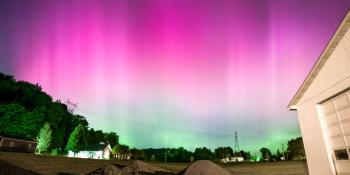Affichage des archives de mercredi, 9 mars 2011
Rapport d'activité solaire
Any mentioned solar flare in this report has a scaling factor applied by the Space Weather Prediction Center (SWPC). Because of the SWPC scaling factor, solar flares are reported as 42% smaller than for the science quality data. The scaling factor has been removed from our archived solar flare data to reflect the true physical units.
Rapport d'activité solaire et géophysique 2011 Mar 09 2200 UTCFait par le NOAA © SWPC et adapté par SpaceWeatherLive.com
Rapport de l'USAF/NOAA sur l'activité solaire et géophysique
SDF numéro 068 publié à 2200Z le 09 Mar 2011IA. Analyse des régions solaires actives et activité du 08-2100Z au 09-2100Z Solar activity was moderate. Two M1 x-ray flares were
observed from Region 1166 (N09W12) which was an Ekc spot group with
a Beta-Gamma-Delta magnetic classification. The area of this region
and the number of spots increased over the last 24 hours. Region
1169 (N20E18) also grew in area and number of spots over the past 24
hours, ending the period as an Esc type spot group with a Beta-Gamma
magnetic classification. The remaining regions were either small
and magnetically simple (Region 1170) or decaying (Region 1164) and
rotating off the visible disk.
IB. Prévisions d'activité solaire
Solar activity is expected to remain
moderate for day 1 (10 March) with a chance for M-class activity
from Region 1166 or Region 1169.
IIA. Résumé de l'activité géophysique du 08-2100Z au 09-2100Z
The geomagnetic field was quiet. The greater than 10 MeV proton flux
remained above the 10 pfu threshold throughout the past 24 hours.
Solar wind speed measured at the STEREO-A spacecraft jumped from
approximately 650 km/s to 870 km/s near 09/0700Z. This jump was
accompanied by southward Bz to -20nT. These observations were
consistent with a shock passage from the CME that originated on
07/2012Z. The greater than 2 MeV electron flux at geosynchronous
orbit reached high levels during the period.
IIB. Prévision de l'activité géophysique
The geomagnetic field is
expected to be unsettled to active, with isolated minor storm
periods possible at high latitudes on day one (10 March), and
primarily unsettled conditions on days two and three (11-12 March).
The CME from 07 March is expected to arrive mid-day on 10 March,
leading to the elevated activity.
III. Probabilité d'éruption solaire du 10 Mar au 12 Mar
| Classe M | 50% | 40% | 30% |
| Classe X | 05% | 05% | 01% |
| Proton | 75% | 50% | 20% |
| PCAF | yellow | ||
IV. Flux Penticton 10.7 cm
Observé 09 Mar 143 Prévisionnel 10 Mar-12 Mar 145/145/140 Moyenne des 90 derniers jours 09 Mar 092
V. Indice géomagnetique A
Observé Afr/Ap 08 Mar 004/005 Estimé Afr/Ap 09 Mar 005/008 Prévisionnel Afr/Ap 10 Mar-12 Mar 020/022-012/018-008/008
VI. Probabilités d'activité géomagnétique du 10 Mar au 12 Mar
| A. Latitudes moyennes | |||
|---|---|---|---|
| Actif | 25% | 25% | 25% |
| Tempête mineure | 20% | 15% | 01% |
| Tempête majeure/sévère | 10% | 05% | 01% |
| B. Hautes latitudes | |||
|---|---|---|---|
| Actif | 35% | 35% | 35% |
| Tempête mineure | 25% | 20% | 05% |
| Tempête majeure/sévère | 15% | 10% | 05% |
Toutes les heures sont indiquées en UTC
Dernières nouvelles
Forum
Unproven theories 483Red Auroras 19Could Cycle 25 be categorized as "historical"? 16May 2024 Geomagnetic Storms from AR 13664 (2) 326AR3664 1108
Plus de messages du forumAidez SpaceWeatherLive.com !
Vous êtes de plus en plus nombreux à consulter SpaceWeatherLive pour suivre l'activité solaire ou aurorale, et avec le traffic les coûts du serveur augmentent. Si vous appréciez SpaceWeatherLive, soutenez notre projet en faisant un don afin que nous puissions continuer à vous informer !

La Météo Spatiale en faits
| Dernière classe X | 15/05/2024 | X2.9 |
| Dernière classe M | 21/05/2024 | M1.9 |
| Dernier orage géomagnétique | 17/05/2024 | Kp6 (G2) |
| Jours sans taches solaires | |
|---|---|
| Dernier jour sans taches solaires | 08/06/2022 |
| Nombre mensuel moyen de taches solaires | |
|---|---|
| avril 2024 | 136.5 +31.6 |
| mai 2024 | 155.9 +19.4 |
| Last 30 days | 158.9 +32.9 |


